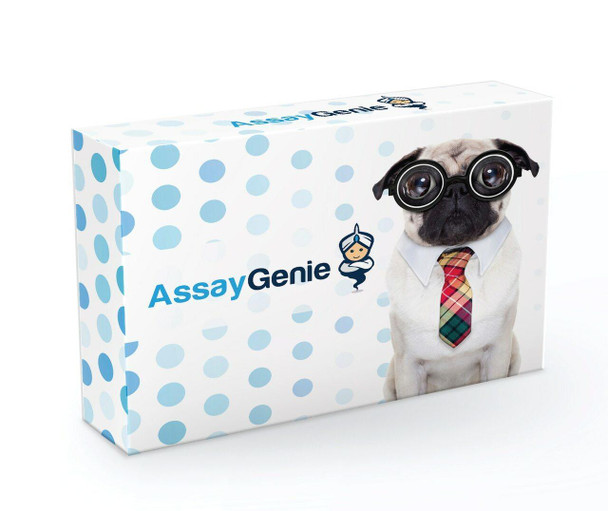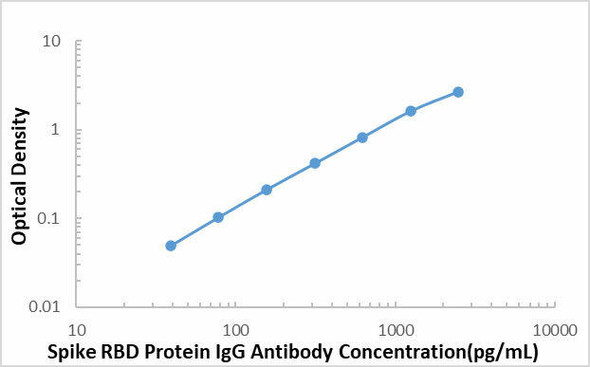SARS-CoV-2 Spike Protein S1 RBD ELISA Kit (HUES03622)
- SKU:
- HUES03622
- Product Type:
- ELISA Kit
- Size:
- 96 Assays
- Sensitivity:
- 0.09ng/mL
- Range:
- 0.39-25ng/mL
- ELISA Type:
- Sandwich
- Synonyms:
- Spike protein S1, S1 subunit, Receptor binding domain, S1RBD, RBD domain
- Reactivity:
- SARS-CoV-2
- Sample Type:
- Serum, plasma and other biological fluids
Description
SARS-CoV-2 Spike Protein S1 RBD ELISA Kit
About COVID-19
SARS-CoV-2, the causative viral agent of the disease COVID-19, is a coronavirus which bears the transmembrane glycoprotein spikes (S protein) typical of viruses in its clade. These spikes are a prominent target of human immune responses and have been found to be highly immunogenic. The receptor-binding domain (RBD) of the S protein is particularly targeted by neutralising antibodies.
The spikes on SARS-CoV-2 allows the virus to enter host cells through the human receptor angiotensin converting enzyme 2 (ACE2), present in alveolar epithelial cells.
The time between initial viral exposure and symptom onset is known as the incubation period. For COVID-19, the average incubation period has been reported to be between five and six days. However, there is considerable variation in incubation time, with some studies suggesting symptoms can appear as soon as three days post-exposure or as late as thirteen days post-exposure.
Fever, fatigue, dry cough are the main symptoms. Some patients could present nasal congestion, runny nose, diarrhea and other symptoms. In severe cases, dyspnea occurred after one week which could lead to acute respiratory distress syndrome (ARDS), septic shock, refractory metabolic acidosis and coagulation dysfunction were rapidly advanced. Particularly, in the course of severe and critical cases, the fever can be moderate or low, and sometimes it is not even obvious. Some patients who showed only low fever, slight fatigue, and etc. without pneumonia manifestations, are able to recover in one week.
How does our SARS-CoV-2 Spike Protein S1 RBD ELISA Kit work?
This ELISA kit uses the Sandwich-ELISA principle. The micro ELISA plate provided in this kit has been pre-coated with an antibody specific to SARS-CoV-2 S1RBD. Samples (or Standards) and biotinylated detection antibody specific for SARS-CoV-2 S1RBD are added to the micro ELISA plate wells. SARS-CoV-2 S1RBD would combine with the specific antibody. Then Avidin-Horseradish Peroxidase (HRP) conjugate are added successively to each micro plate well and incubated. Free components are washed away.
The substrate solution is added to each well. Only those wells that contain SARS-CoV-2 S1RBD, biotinylated detection antibody and Avidin-HRP conjugate will appear blue in color. The enzyme-substrate reaction is terminated by the addition of stop solution and the color turns yellow. The optical density (OD) is measured spectrophotometrically at a wavelength of 450 ± 2 nm. The OD value is proportional to the concentration of SARSCoV-2 S1RBD. You can calculate the concentration of SARS-CoV-2 S1RBD in the samples by comparing the OD of the samples to the standard curve.
SARS-CoV-2 Spike Protein S1 RBD ELISA Kit Contents
| Component | Specifications | Storage |
| Micro ELISA Plate (Dismountable) | 8 wells × 12 strips | -20°C, 6 months |
| Reference Standard | 2 vials | -20°C, 6 months |
| Concentrated Biotinylated Detection Ab (100×) | 1 vial, 120 μL | -20°C, 6 months |
| Concentrated HRP Conjugate (100×) | 1 vial, 120 μL | -20°C, 6 months (Protect from light) |
| Reference Standard & Sample Diluent | 1 vial, 20 mL | 2-8°C, 6 months |
| Biotinylated Detection Ab Diluent | 1 vial, 14 mL | 2-8°C, 6 months |
| HRP Conjugate Diluent | 1 vial, 14 mL | 2-8°C, 6 months |
| Concentrated Wash Buffer (25×) | 1 vial, 30 mL | 2-8°C, 6 months |
| Substrate Reagent | 1 vial, 10 mL | 2-8°C, 6 months (Protect from light) |
| Stop Solution | 1 vial, 10 mL | 2-8°C |
| Plate Sealer | 5 pieces | N/A |
Other Materials Required
- Microplate Reader with 450 nm wavelength filter or dual-wavelength (450/630 nm)
- High-precision transfer pipette, EP tubes, and disposable pipette tips
- Incubator capable of maintaining 37°C
- Deionized or distilled water
- Absorbent paper
- Loading slot for Wash Buffer
Sample Collection and Preparation
Serum: Allow samples to clot for 2 hours at room temperature or overnight at 2-8°C before centrifugation for 20 min at 1000×g at 2-8°C. Collect the supernatant to carry out the assay.
Plasma: Collect plasma using EDTA or heparin as an anticoagulant. Centrifuge samples for 15 min at 1000×g at 2-8°C within 30 min of collection. Collect the supernatant to carry out the assay.
Cell lysates: For adherent cells, gently wash the cells with a moderate amount of pre-cooled PBS and dissociate the cells using trypsin. Collect the cell suspension into a centrifuge tube and centrifuge for 5 min at 1000×g. Discard the medium and wash the cells 3 times with pre-cooled PBS. For each 1×106 cells, add 150-250 μL of pre-cooled PBS to keep the cells suspended. Repeat the freeze-thaw process several times or use an ultrasonic cell disrupter until the cells are fully lysed. Centrifuge for 10 min at 1500×g at 2-8°C. Remove the cell fragments and collect the supernatant to carry out the assay.
Cell culture supernatant or other biological fluids: Centrifuge samples for 20 min at 1000×g at 2-8°C. Collect the supernatant to carry out the assay.
Note for samples:
- Tubes for blood collection should be disposable and non-endotoxin. Samples with high hemolysis or excessive lipids are not suitable for ELISA assay.
- Samples should be assayed within 7 days when stored at 2-8°C. Otherwise, samples must be divided and stored at -20°C (≤1 month) or -80°C (≤3 months). Avoid repeated freeze-thaw cycles. Prior to assay, thaw frozen samples slowly and centrifuge to remove precipitates.
- Please predict the concentration before assay. For tested samples, a preliminary experiment is strongly suggested to determine the optimal dilution factors for their particular experiments.
- If the sample type is not included in the manual, a preliminary experiment is suggested to verify its validity.
- If a lysis buffer is used to prepare tissue homogenates or cell culture supernatant, deviations may occur due to introduced chemical substances.
- Some recombinant proteins may not be detected due to mismatching with the coated antibody or detection antibody.
Reagent Preparation
- Bring all reagents to room temperature (18-25°C) before use. If the kit will not be used in one assay, only take out the necessary strips and reagents for the current experiment and store the remaining strips and reagents as instructed.
- Wash Buffer: Dilute 30 mL of Concentrated Wash Buffer with 720 mL of deionized or distilled water to prepare 750 mL of Wash Buffer. Note: If crystals have formed in the concentrate, warm it in a 40°C water bath and mix gently until the crystals have completely dissolved.
- Standard working solution: Centrifuge the standard at 10,000×g for 1 min. Add 1.0 mL of Reference Standard & Sample Diluent, let it stand for 10 min, and invert it gently several times. After it dissolves fully, mix thoroughly with a pipette. This reconstitution produces a working solution of 25 ng/mL. Prepare serial dilutions as needed using the following method:
- Biotinylated Detection Ab working solution: Calculate the required amount before the experiment (100 μL/well). Slightly more than calculated should be prepared. Centrifuge the Concentrated Biotinylated Detection Ab at 800×g for 1 min, then dilute the 100× Concentrated Biotinylated Detection Ab to 1× working solution with Biotinylated Detection Ab Diluent (Concentrated Biotinylated Detection Ab: Biotinylated Detection Ab Diluent = 1:99).
- HRP Conjugate working solution: Calculate the required amount before the experiment (100 μL/well). Slightly more than calculated should be prepared. Centrifuge the Concentrated HRP Conjugate at 800×g for 1 min, then dilute the 100× Concentrated HRP Conjugate to 1× working solution with HRP Conjugate Diluent (Concentrated HRP Conjugate: HRP Conjugate Diluent = 1:99).
Take 7 EP tubes, add 500 μL of Reference Standard & Sample Diluent to each tube. Pipette 500 μL of the 25 ng/mL working solution to the first tube and mix to produce a 12.5 ng/mL working solution. Continue diluting sequentially to produce the following concentrations: 12.5, 6.25, 3.13, 1.56, 0.78, 0.39, and 0 ng/mL.
SARS-CoV-2 Spike Protein S1 RBD ELISA Kit Assay Procedure
- Determine wells for diluted standard, blank, and sample. Add 100 μL each dilution of standard, blank, and sample into the appropriate wells (It is recommended that all samples and standards be assayed in duplicate). Cover the plate with the sealer provided in the kit. Incubate for 90 minutes at 37°C. Note: Solutions should be added to the bottom of the micro ELISA plate well. Avoid touching the inside wall and causing foaming as much as possible.
- Decant the liquid from each well, do not wash. Immediately add 100 μL of Biotinylated Detection Ab working solution to each well. Cover with the plate sealer. Incubate for 1 hour at 37°C.
- Decant the solution from each well, add 350 μL of wash buffer to each well. Soak for 1-2 minutes and aspirate or decant the solution from each well. Pat it dry against clean absorbent paper. Repeat this wash step 3 times. Note: A microplate washer can be used in this step and other wash steps. Make the tested strips in use immediately after the wash step. Do not allow wells to dry.
- Add 100 μL of HRP Conjugate working solution to each well. Cover with the plate sealer. Incubate for 30 minutes at 37°C.
- Decant the solution from each well, and repeat the wash process 5 times as conducted in step 3.
- Add 90 μL of Substrate Reagent to each well. Cover with a new plate sealer. Incubate for about 15 minutes at 37°C. Protect the plate from light. Note: The reaction time can be shortened or extended according to the actual color change but should not exceed 30 minutes. Preheat the microplate reader for about 15 minutes before OD measurement.
- Add 50 μL of Stop Solution to each well. Note: Adding the stop solution should be done in the same order as the substrate solution.
- Determine the optical density (OD value) of each well at once with a microplate reader set to 450 nm.







